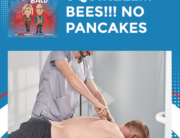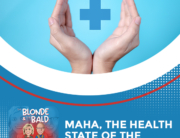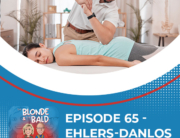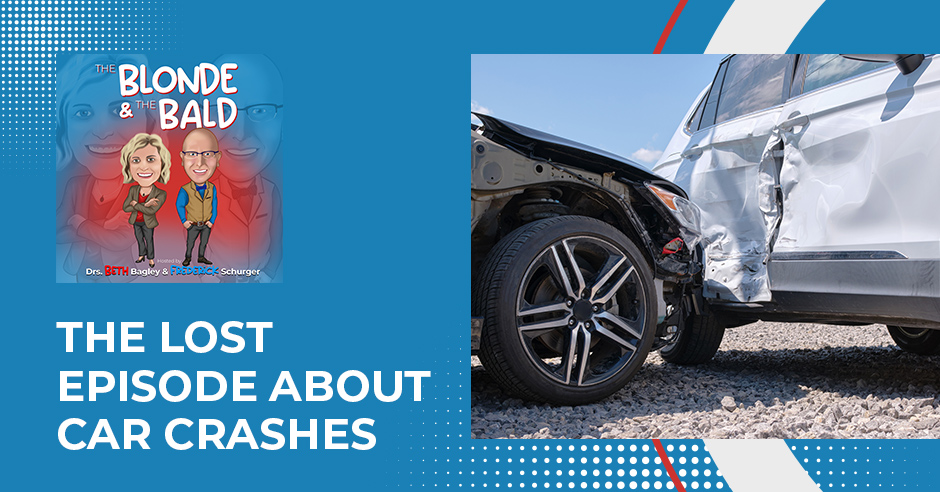
Do you know what happens when you record a podcast from home before a snowstorm comes in? You talk about car accidents and then forget that you didn’t rename the folder!!! There is a lot of great information about car accidents, though, and you might hear this at the time that you realize your pain may have come from an accident several months ago! Tune in as Dr. Frederick Schurger and Dr. Beth Bagley share practical things you can do if you ever get into a car accident.
—
Watch the episode here
Listen to the podcast here
The Lost Episode About Car Crashes
We are having fun on the show. We are wrapping up for the end of 2022. We’re recording this on December 22nd, 2022 at 5:00 PM on a very cold day. We’re both at home because we closed our offices early in case the snow was bad. What were they predicting for St. Louis?
They were predicting about 5 inches. We’re going to get 2.5.
That’s generous. On Monday, it was something like 8 to 10. On Tuesday, it was already down to 4 to 6. Ever since, it has been 2 to 4. Actual accumulation, they were saying an inch and a half. It’s gotten so cold that we didn’t get the snow.
It’s blowing hard. I bet it’s blowing harder in Springfield though because it’s always windy there.
I have a funny story. As these models and predictors come out with whatever it is, whether it is the virus that’s coming after you, the hurricane, or in this case, the snowstorm they were predicting, there were a lot of different models that they used to figure out all the math to say how bad something is going to be.
The most reliable predictor, and you have some of these in your office as well, was a nurse that came in with one of my patients. She was making sure she could drive and walk in. Her comment was her knees ache when the weather changes. In the cold snap wetness, she said she had that deep bone ache going on. She’s like, “I got nothing. We’re not going to get real snow.”
I believe that.
That, I find, is more reliable consistently than what these forecasters say. I hate to say it. Someone with my engineering and scientific background wants to believe in all of these nice technology pieces. I had no faith in that one.
You never know. There is such science to it, but then, there’s also such chaos.
The worst part is when I was growing up, I had five channels of TV. Even worse, by midnight, after Johnny Carson was done or maybe it was Dave Letterman that was on at that point in time, when that final talk show host finished up, they played the national anthem. They turned the station off until about 5:00 AM or 6:00 AM when the news started back up to tell you what the weather was going to be like that day and if there was any traffic or any problems. It was a completely different world. Here, you have a 24-hour news cycle.
At this point, it’s fear. I don’t want to say the bad word.
It is fear porn. Let’s use the word that is appropriate. It is all about what is going to scare you into watching, paying attention, and putting your eyeballs and attention to their channel.
The scarier, the better. Let’s get scarier.
The storm of the century is what I was hearing.
It’s named Elliot.
I’ve got a patient named Elliot. She was in. She was moody enough that I’m like, “If this was her, she’d be threatening to be this kind of snowstorm and then not deliver.” I’m okay with that. We got her adjusted so that way, she could have a Merry Christmas and not get cold.
I’m happy that some people got off school and that kind of thing. There are not going to be so many delays and people are still going to be able to get where they need to be. There are still some delays. I’m not saying there isn’t, but people get where they need to be for Christmas, which is nice.
This cold is no joke.
That’s what we have to be aware of. That reminded me of some of our patients with Reynaud’s. How much do you know about that?
Unfortunately, my wife’s got it. I know a couple of patients who have it.
Could you explain it? I don’t know a ton about it. I know what happens but what does she experience?
That’s the thing. Usually, in the extremities, you cannot get the blood flowing into your hands and your feet.
What does it look like when she gets it? It’s a color change that happens, right?
It is. Everything flushes. It doesn’t necessarily need to be a cold weather snap like this.
The temperature variation can do it. Even hot can do it.
That’s the problem. You can have it any time of the year. It could be happening in the middle of the summer and not just in the middle of winter. I put on heavy gloves to shovel and make a path to our garage. I didn’t have anything on my ear, so my ears blanched. It’s that same situation except it is extremely painful. It is cold to the touch because there’s not enough blood flow getting into the extremities. There is a neurological background to it, but quite honestly, it’s strange. It’s strange enough that I don’t feel like I’ve got a good understanding of it. You’re probably talking to folks who do vascular work day in and day out.
What people noticed with the people I’ve talked to is that the pain usually comes on when the blood flow returns. It goes from white to red. That’s when it’s super painful.
That’s like any situation. This is where it is a neurological issue more than anything else. The blood flow is halted. Once that’s halted, nothing is getting through. All of a sudden, everything opens up, if I understand it correctly. It’s like anything else. If you put a rubber band around your finger, you cut off the circulation. It’s the same principle except for instead of an outside force, it’s an inside force that’s preventing your body from working the way it’s supposed to.
I remember one of my professors in chiropractic school using that as a way to explain to people subluxation. It’s a rudimentary way to explain subluxation. If your finger is getting the blood cut off from it because we got the rubber band around, what’s the answer? Take the rubber band off. That’s the simplicity of chiropractic in a way.
If your finger is getting the blood cut off from it because you’ve got a rubber band around it, what’s the answer? Take the rubber band off. That’s the simplicity of chiropractic, in a way.
Our nervous system is being impinged by misalignment. A simple way to explain it is when we need to take the rubber band off, it is to move bones off of nerves. It’s a simple way. Chiropractors hate when we explain it, but honestly, most people understand it that way. You can look at it. You can dig down into it, in general. Nerves are affected when there’s a misalignment. Whether we want to call it pinching or not, I don’t want to get into that.
From the way the upper cervical world that we work in, when that atlas and axis go out of place, the ligaments holding that brainstem and spinal cord are effectively causing a pinch on the nerve except for it’s a pinch on the spinal cord. That is because the two ligaments that are attached from the inside of the bone to the spinal cord itself are coming off straight across.
With others, when we get down further into the upper back, they’re at an angle. That’s the best way to think about it. It allows for some flection back and forth, and some motion up and down in those lower areas. When you think about it, it’s got to be able to move. In the upper neck, at the base of the skull at C1, C2, and maybe even C3, which I’ve got to get some confirmations from some people who are doing cadaver studies, those ligaments are coming straight off. They’re very taut. They’re some of the strongest ligaments of the body.
If you’ve ever twisted your ankle, we understand that’s a weak ligament involved there. The ligaments that hold the upper cervical in place, if you have your head turned and you’re in a car accident, you may tear one of those ligaments around the upper cervical. Those ligaments, what they call the dentate ligaments, that come straight off the bones into the spinal column are some of the strongest ligaments of the body. They will not tear. In fact, before they will tear, they will do something called an avulsion to the spinal cord itself that will be more traumatic.
If you can imagine a ligament pulling out of a tissue, that’s what we’re talking about here. That would not be a chiropractic problem generally. Let’s pray that if you are ever in that kind of situation that there is a neurosurgeon that knows how to put you back together. It might be a traumatic and potentially deadly situation if those ligaments pull out of the spinal cord.
That brings up a good point of practical ways if someone is to get into a car accident. We don’t want to, but at this time of year, there are fender benders because there are icy conditions. Some things are high speed. Some things are low speed. Let’s say you are in a car. You look up and there’s a car coming at you. You can see it in the rearview. If you have a second to think about it, the first thing I would do is make sure my head is straightforward. Even a slight turn is not good. Face straightforward. Maybe even I would tuck a little bit. I’ll then make sure my head is against the headrest.
Your headrest should not be down the middle of your head.
That’s such an important thing.
It should be above your head.
I’m tall, so I have it as high as possible.
That’s the problem. For people like you and me who are tall, even having that thing as high as it can be, it is usually above the ear for us. It needs to be above the crown or the top of your head. For most people, you need to make sure that thing is set higher because that will protect you from a potential whiplash-style presentation.
A whiplash in general, so people can understand what that is. When my grandparents were alive, and I’m thinking back in maybe even the ‘50s, my grandfather was a chiropractor. My grandmother got a terrible whiplash injury. This was before the time of headrests. Headrests weren’t a thing. If you look back at older cars, if you’re looking at them, the seats go across and the heads were above the seats. Safety has come into play in why headrests are there and are not comfortable. It’s because what was happening is the seat was right there. A car would hit from behind and the head would go back. It goes back and then flies forward.
Yes and no. There are two parts to that.
Go for it.
One, it’s going back, but also, you are dropping down while your lower body is going up. It is not intuitive until you have seen it happen on a slow-motion camera video. I’ve done a cross-whiplash series, which was fantastic. In a normal whiplash, you drop down and backward. Your head goes back, and then it comes back up. You get this weird presentation. What it’ll end up doing almost every time, and your neck should have a C-curve facing backward, is it will invariably create an S-shaped curve. Quite honestly, it is torn ligaments. Your body doesn’t have the stability that it’s supposed to have to go back to where it’s supposed to be. A lot of people have excessive motion at individual segments which can lead to other health issues.
With whiplash, there is soft tissue injury. We also will have a bone misalignment. When I see a car coming, I’m going to tuck and put my head against there so that when I get plowed into my head, it at least doesn’t fly back at all. Hopefully, I don’t fly up at all. I’m sure I will a little bit. If you get hit hard enough, you’re going to have some motion. If my head was turned and I was leaning forward, I’m going to not only have soft tissue injury with that, but I’m going to have bone misalignment, too.
This gets into a different soft tissue. If you’re stable going and straight ahead, you’re going to tear some stuff up. It’s going to happen. You can’t avoid that. Let’s say I want to turn my head to the right. I have a hard stop. I can’t turn any further than that. It’s not because of something out of place, which is the same thing to the left, but because there are what we call check ligaments that prevent your head from moving any further.
When you have your head turned to one side or the other up or down, those same check ligaments that are balancing and keeping you from going anywhere else have the potential to get torn. It doesn’t take a whole lot of force. If my memory serves, as little as 30 pounds of force is enough to tear one of those check ligaments in the process. It doesn’t take a whole lot. It’s a cross-ligament. This is a check and stability ligament. This is why we have people who are in car accidents, especially women over men because they tend to have an intrinsically weaker ligament structure across the board. Here’s the worst part. You and I are sitting in a car. All we are doing is sitting. We’re sipping our coffee after a seminar.
I’m drinking tea. I want this to be correct.
That’s fine. You can have tea. I’m having coffee. We’re both sitting. We’re like, “We’re going to get hit rear-ended.”
We’re doing the exact same thing.
Our feet are on the ground. Neither of us is touching whatever it was.
That being said, we are about the same height, too.
We’re both at six feet. You’re going to have more trauma in a car accident than that because the female anatomy has a weaker ligament structure. This is why we are hearing about any sort of these trans athletes.
They’re in contact with female athletes.
If it’s a female athlete with a trans woman, that can lead to a real problem. We heard about this with the NHL and their thing.
The NHL or the NFL?
It was the NHL.
If in a whiplash we are both in the car together, female anatomy is more prone to these injuries because intrinsically, we are made differently. I don’t want to say weaker. I’m going to say differently. Being hit in a certain way, we’re going to get more of the accident. It might be why we see more women with exactly whiplash injuries than men in my office. I never thought about it that way.
The female anatomy is more prone to injuries because, intrinsically, women are made differently. It might be why we see more women with whiplash injuries than men.
I would phrase it as not necessarily there’s a weakness in an engineering sense, but it is a less densely-packed ligament. That is the technical way to describe it. Here’s the worst part and what men have to appreciate when they’re in a car accident as well. It’s not because you’re a male in a car accident that it means damage has not happened. With the ligament failure point, if we’re on a graph and going to my right is more failure whereas zero failure or this is a failure for a woman and this is a failure for a man, it doesn’t matter for women. If you pass this point, you have problems. For men, if you pass this point, you have the same problems. It needs to be addressed and fixed. Otherwise, life will not get better for anyone.
What would you recommend to a patient or not a patient yet? Chiropractors aren’t going to be open until after Christmas. Let’s say they got into a car accident. They’re safe and sound. They’re at home. What would you recommend they do first?
First, they’re going to do some good research to make sure they got a good chiropractor they’re going to who understands it.
We agreed that they were going to find a chiropractor, but they can’t get in.
They can’t get to one of us. If you already have a friend who’s a chiropractor, get in sooner than later. That’s going to be the first. The sooner that you can get in, the better.
I agree. This person cannot see us for 3 or 4 days.
The reality is simply you’re going to take it easy. You are not going to overdo it. You’re not going to say, “I was going to start that new workout routine. It’s Christmas. I’ve already had all the Christmas parties. I’m going to start my workout routine a week early.” Don’t do that.
Should they put heat on their neck?
I’m torn on that. That is really a good question.
We’re told that you’re supposed to ice an acute injury.
The entire rest, ice, compress, and elevate, I don’t know. Apparently, it was made up on the back of a napkin at some conference. Science doesn’t support that. All of these things are bad. The simplest thought would be to take it easy and get back into your routine.
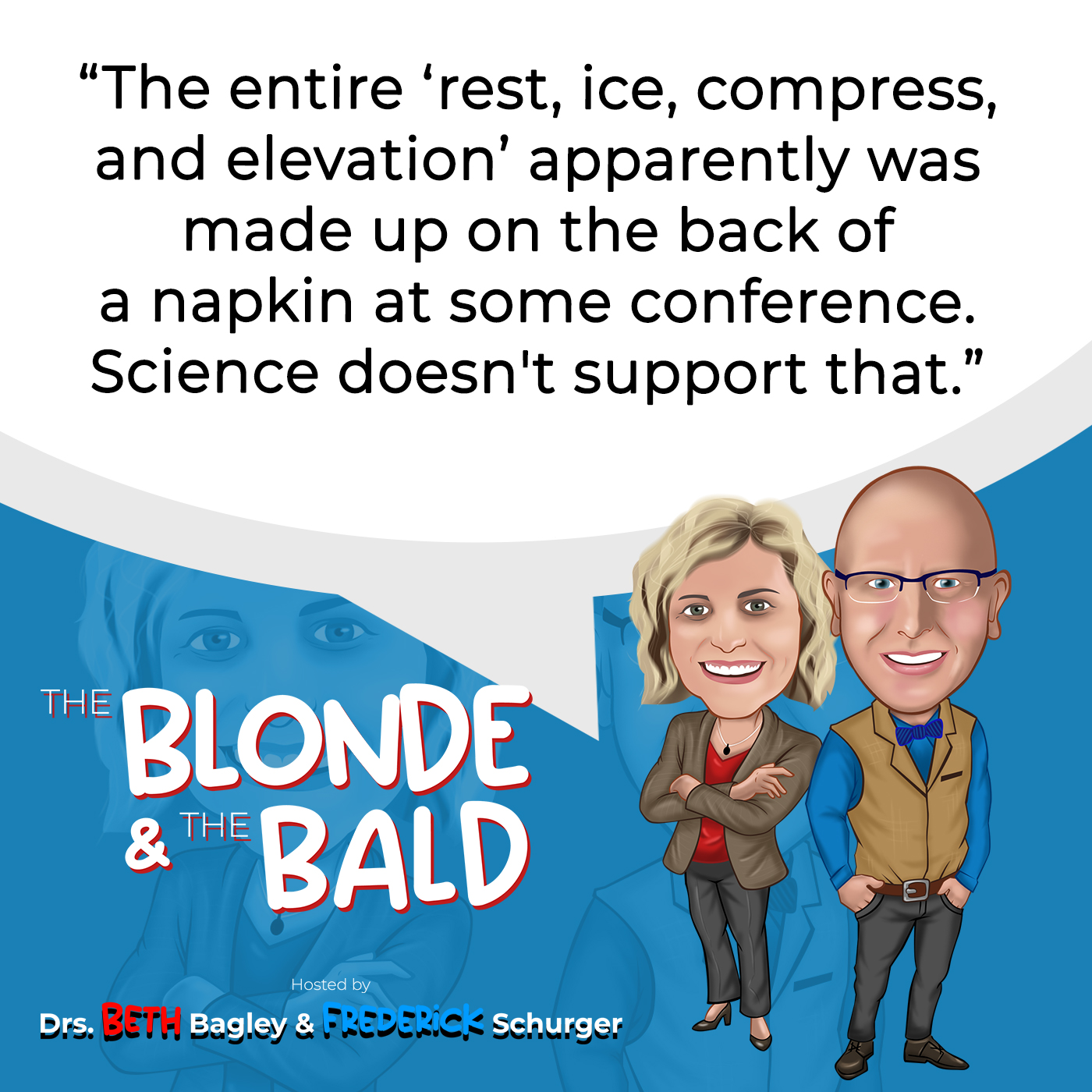
I have no research to back this up, but gentle, slow ranged emotion multiple times a day to keep things moving.
Do gentle, slow range of motion multiple times a day to keep things moving.
I would agree.
Back in the ‘80s, you would see people walking around with a neck brace on. They’re like, “I had the whiplash.” You’re like, “Let’s put something in to stop it.” If you have a broken arm, you need to have something on there to stop the movement so that the bone goes together.
What’s curious is unless it’s joint, they would not recommend putting you into a sling anymore to immobilize the entire arm.
You don’t want to immobilize the joint, but I’m talking about an actual broken bone.
That’s a different kind of immobilization.
Back in the ‘80s, they’d have neck braces. They’re like, “Why don’t we see those anymore?” We come to find out those were not a good idea because people got hurt and the injuries were prolonged with those. I would recommend a patient to talk to their doctor about this. I’m not your doctor, but you can come to see either of us. Do gentle ranges of motions going left and right and ups and downs.
I would emphasize the ups and downs, that yes nodding motion, more than I would even do the left and the right. I tell my patients as we’re doing their neck exercises, which are yeses, noes, and a head glide, to go into it as far as they can comfortably. Stretch is fine, but going into pain is no good. That’s the way I would approach it. Until I could get in, the sooner the better.
I agree with that.
This goes back to what’s going on with the NFL and their injuries on the field. When you have an NFL team, their medical team is there as well. You usually have a PT. You probably have an orthopedic surgeon on staff to do an evaluation. Oftentimes, these guys, if they injure a knee, a shoulder, or something that requires surgery, they’re going to get them into surgery within about 24 hours if not sooner. The reason is because of the way the ligaments heal. The ligaments in that first 48-hour window after any injury, whether it be that, a car accident, or a twisted ankle, if you don’t get back into normal motion and/or correct the injury, it lays down some of the least strong ligaments of the body. It takes months to years to fix that, or never.
If they can get everything stitched and moving the way it’s supposed to, the ligaments will align properly. You can imagine building a house. If there’s some tragedy, all you do is put up sticks from the wind. You grab a bunch of sticks and put those over the windows instead of putting up a sheet of plywood. Sometimes, you’re like, “Those sticks work except for the water that’s still coming in through the window.” The plywood is a temporary fix, but it’s certainly better than not having a window. This ends up being a tricky situation as the body is healing itself.
I would probably do some yes-nodding motions and some noes. I’d be more generous with the yes-nodding motions than I would with the noes because if we get too much rotation, it may aggravate things in an unhappy way. The primary motion of the bones in the spine, especially in the neck, is a forward-to-backward motion that is conducive to that yes nodding motion.
With that being said, if a person, let’s say, on a Monday morning on the way to work gets into a whiplash situation, should they take the rest of the day off and go find an upper cervical, especially Blair chiropractor?
That might not be a bad idea. If you get into one of those car accidents, and all of a sudden, you’re like, “I’ve got a problem.” The sooner, the better. For you and me, we get somebody who’s been in a car accident as a new patient. I tend to do a more thorough workup so that way, we can work with the insurance on some of those. Whether I’m taking the insurance or not, I still want to make sure that all the exam covers what needs to be covered because sometimes, we find stuff along the way. On top of that, we need time to analyze those films, and oftentimes, it’s a busy day for us. We’ve got time to take the picture.
We don’t have time to look through them. That way, at least, if you come in the day of, by the next day we could maybe get your first adjustments done. We don’t want to rush that process.
We want to make sure we’ve got everything figured out and know exactly how to put the bone back into place. That way, the body can start healing.
One of the last things I want to go over with whiplash is that we, as doctors, often see chronic whiplash cases. These could be 10, 15, 20, or 30 years down the line when they finally come in for care. They may have degeneration at this point. They also have, sometimes, disease processes going on. I saw someone with fibromyalgia. We could go back many years as something we see.
There’s a relationship between these neck injuries and not getting the care you need when they happened and then the disease process turning on over time. Your body can only handle so much. I want to tell people it’s not too late. That injury may have happened when you were 20 and now you’re 60, but it’s not too late to get the care you need. We see miracles in our office when people have been dealing with symptoms.
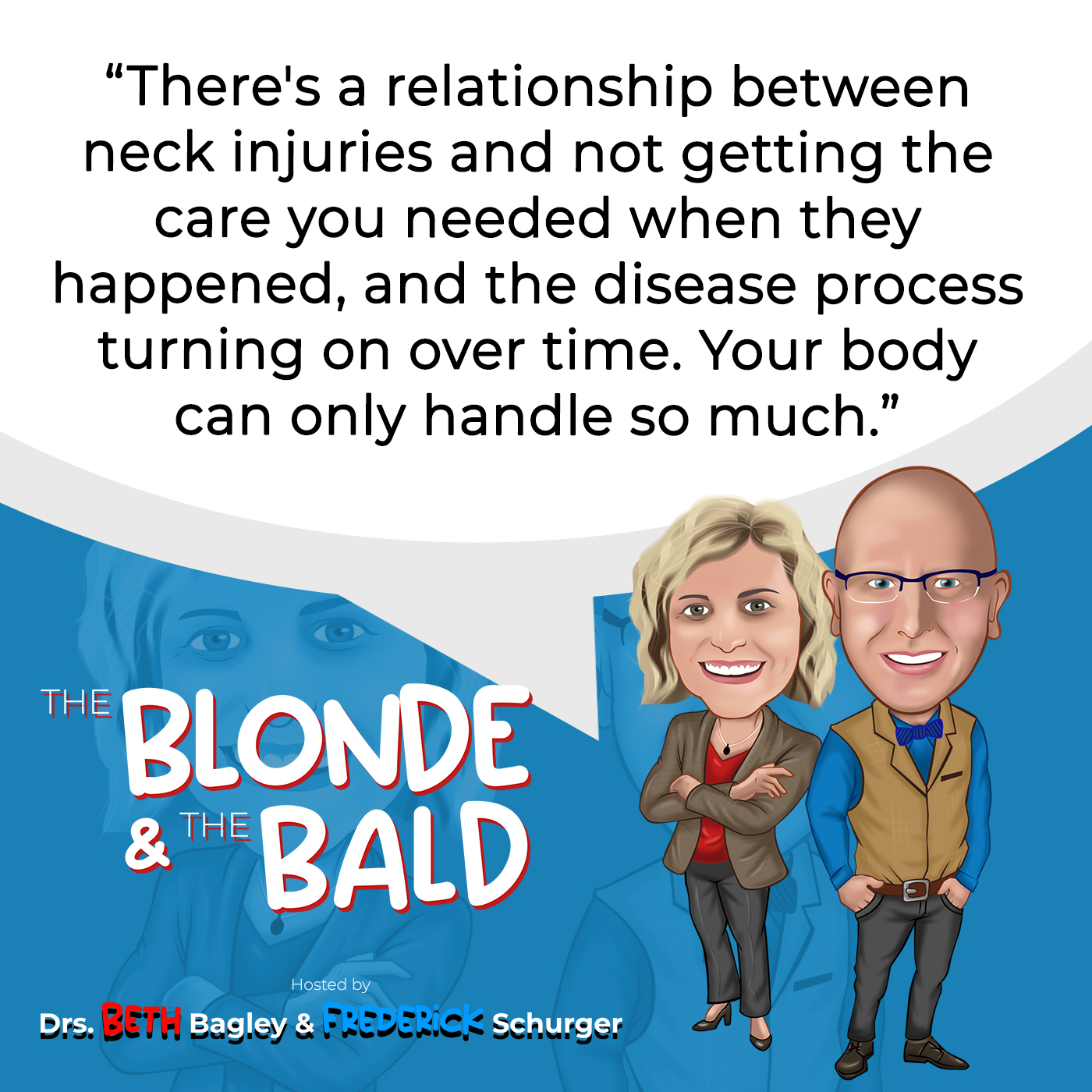
I’m thinking of a woman with fibromyalgia. That chronic pain for years and out of most of her pain in weeks, which is remarkable. That doesn’t always happen with fibromyalgia so quickly, but there’s no other reason other than an upper cervical subluxation or that cranial cervical junction being shifted. It’s not too late to get the help you need. You need to find the right doctor. We’re in the Midwest, but there are some of us all over the country. Go to the Blair website, which is BlairChiropractic.com. It’s not too late. Come and get the help you need.
There’s a diagnosis that a lot of people aren’t appreciative of what is called Cranial Cervical Syndrome. This is a number of different things that include vertigo, back and neck pain, and severe migraines or headaches. There are a number of other bits and pieces to it. I’ve got a lot of patients that when we start saying, “Take a look at this list. How many of these do you have?” they’re like, “All but that one.” What that ends up being is certainly the instability of the upper neck oftentimes from a car accident whiplash-style.
It’s also a situation where the tonsils, not the tonsils in the back of your throat but rather the tonsils coming off of your brain, have dropped down past the skull. They’re starting to cut off communication of your cerebral spinal fluid. This is why a lot of people are much more relaxed. They have fewer problems when they are laying on their back because those tonsils pull back up. As soon as they put themselves in gravity, those tonsils start pulling down into that space. We call this Cerebellar Tonsillar Ectopia, which is horrible. CTE also refers to something else in the world. I can’t remember what it is, but it’s also a whiplash football type of thing.
We have technically two CTEs that can be related to football. Dr. Scott Rosa and Michael Freeman put out a paper several years ago. It said when they looked at MRIs of people laying down and when they were seated upright in gravity in these upright MRI units across the country, there was a significant increase of people that did not show any of these cerebellar tonsils dropping down past the brain. There was a significant increase when they sat them up and started dropping down.
It only makes sense. It’s gravity.
More importantly, that’s when they have their symptoms. The doctors aren’t asking these questions not because they’re not smart, but because I don’t think they’ve put these pieces together. The question is, “When do you have your symptom? You have this symptom. You have it all the time.” The patient says, “I don’t have a problem when I’m laying down.” It’s like, “You’re resting,” but they don’t put together the part of the biomechanical change that shouldn’t be happening.
That’s the other problem. This should not be happening. Yet, in some people, especially people who’ve been in a car accident, we see this much more commonly. I want to say it’s something like 25%. It is a big increase between the two groups. Don’t quote me on that, but I know that number. I’ll have a chance to look it up. We can revisit it at some point in time in the future. In any case, we help people like this all the time. People need to be aware of it.
That’s why we do this show. It’s not just so we can talk to each other. It’s so that the people tuning in have some resources available. If you go to urgent care or the hospital after a whiplash, you get an X-ray. They make sure nothing is broken. That’s great.
They might do a CT because the CT gets all that information, plus it takes to see if there’s any bleeding that isn’t supposed to be there. Sometimes, that’s what you see.
It’s all good stuff. I’m happy with that. They’re like, “Take it easy.” I agree with that. They then give them muscle relaxers, either some painkillers, ibuprofen, NSAID, or something like that and say, “Good luck.” There is no follow-up with that. It’s, “Go on.” Most people don’t go back to urgent care and say, “That didn’t help.” They say, “I’m hurt. It’ll get better.” Maybe sometimes, it does. In general, when you’ve had a whiplash injury, you’re going to have misalignment that has happened from it. You may be one of the lucky ones where it went right back where it’s supposed to, but typically, it doesn’t. That’s why we exist.
We told the story of how I was looking down to my right at a stop sign or a stop light and all of a sudden, I had a Jeep back right into me, knocking me out of the place.
It wasn’t even high speed.
I was certainly stopped. A lot of these things are never at high speed.
It doesn’t take much.
People have died in injury accidents at less than five miles per hour. Let’s put that in the mix. It exists. It happened in Florida, which is where this is referenced. Slow-speed accidents are accidents. Motor vehicle collision is nothing to laugh about. As long as it’s not to you, especially, you can laugh at somebody who you don’t like, but even then.
You can’t. That’s mean.
You shouldn’t. I know.
You can see it on TV and be like, “Okay.” It could be fake stuff or Hollywood stuff.
Is there anything else you want to talk about?
It doesn’t take much to cause this injury, so find us.
We’re wrapping up. This should be the last one for 2022. We’ve got a lot to be grateful for. We’ve had a good year.
It has been a great year.
You’ve got a new associate that’s going to be fantastic.
She graduated from chiropractic school.
I know. I’m excited.
Dr. Shilo Trowbridge is joining Precision Chiropractic, which is exciting. We are waiting for her to become licensed in the state of Missouri. She’s working as a chiropractic assistant and helping me, but she’s not allowed to adjust patients anymore until she gets her license. It’s a weird limbo.
The irony of the situation. She’ll have her license before too long. I’m certain. We might be able to get her certified this 2022.
That’d be great.
We can get you certified this 2022 in Blair.
I’ll do it. I hear there’s a new certification process.
I hope so.
There’s something new brewing where I can become instructor certified. I’ll have to go through that.
I don’t know if it’s that easy, but you still have to go through the X-ray analysis portion. We’ve got to figure out if they fixed that yet. That’s another story.
I can do it.
You’ll get it done. You’re overdue. We both got our CBCTs going. We’re having a great time with that. That is fantastic. I got my system upgraded a little bit to be more similar to what you have.
It still works the same. It’s a better computer.
It’s a different computer. No one will know the difference. It’s a functional thing. There was some security stuff that makes this a little bit better.
That’s good.
We had a good year. I’ve seen a lot of patients get better.
It makes it all worth it. There’s a lot of stress from being a business owner and trying to keep a practice going, especially the last couple of years during the pandemic.
That’s in general. It’s been a good year. ‘23 is going to be a fantastic year.
I’m excited for ‘23. It’s going to be a great year.
We’re going to find some people. This will finally be out as we start ‘23. I hope. I suspect we’re going to see some amazing things. We’re going to see some amazing recoveries.
I can’t wait to share it with everyone reading. I’m going to do a better job documenting some patients as they come through.
The other thing that we’ll end up doing here for ‘23 as people are tuning in through this episode here, we’re going to start getting set up to do some interviews with some patients. That way, they can tell their story. We can have fun that way.
That is super fun. It’s powerful hearing someone’s own story.
Let’s wrap it up. This is going to be a good place to call it for 2022. I know I’m going to go try to go hunting as long as it doesn’t get too bitter or too wet. I think it’s going to be a little bit too bitter and too wet, so we’ll see what happens.
My website is PrecisionChiropracticSTL.com.
Mine is KeystoneChiroSPI.com. We wish you all a great and prosperous 2023. We look forward to you tuning in soon.
Happy New Year, guys.
Happy New Year.
Important Links


